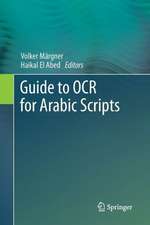Non-Cooperative Target Tracking, Fusion and Control: Algorithms and Advances: Information Fusion and Data Science
Autor Zhongliang Jing, Han Pan, Yuankai Li, Peng Dongen Limba Engleză Hardback – 9 iul 2018
This book gives a concise and comprehensive overview of non-cooperative target tracking, fusion and control. Focusing on algorithms rather than theories for non-cooperative targets including air and space-borne targets, this work explores a number of advanced techniques, including Gaussian mixture cardinalized probability hypothesis density (CPHD) filter, optimization on manifold, construction of filter banks and tight frames, structured sparse representation, and others. Containing a variety of illustrative and computational examples, Non-cooperative Target Tracking, Fusion and Control will be useful for students as well as engineers with an interest in information fusion, aerospace applications, radar data processing and remote sensing.
| Toate formatele și edițiile | Preț | Express |
|---|---|---|
| Paperback (1) | 1161.06 lei 6-8 săpt. | |
| Springer International Publishing – 10 ian 2019 | 1161.06 lei 6-8 săpt. | |
| Hardback (1) | 1167.33 lei 6-8 săpt. | |
| Springer International Publishing – 9 iul 2018 | 1167.33 lei 6-8 săpt. |
Preț: 1167.33 lei
Preț vechi: 1459.15 lei
-20% Nou
Puncte Express: 1751
Preț estimativ în valută:
223.38€ • 238.86$ • 186.24£
223.38€ • 238.86$ • 186.24£
Carte tipărită la comandă
Livrare economică 17 aprilie-01 mai
Preluare comenzi: 021 569.72.76
Specificații
ISBN-13: 9783319907154
ISBN-10: 3319907158
Pagini: 377
Ilustrații: XIX, 340 p. 142 illus., 80 illus. in color.
Dimensiuni: 155 x 235 mm
Greutate: 0.68 kg
Ediția:1st ed. 2018
Editura: Springer International Publishing
Colecția Springer
Seria Information Fusion and Data Science
Locul publicării:Cham, Switzerland
ISBN-10: 3319907158
Pagini: 377
Ilustrații: XIX, 340 p. 142 illus., 80 illus. in color.
Dimensiuni: 155 x 235 mm
Greutate: 0.68 kg
Ediția:1st ed. 2018
Editura: Springer International Publishing
Colecția Springer
Seria Information Fusion and Data Science
Locul publicării:Cham, Switzerland
Cuprins
Introduction.- Part I Multi-Target Tracking.- Gaussian mixture CPHD filter with gating technique.- Detection-guided multi-target Bayesian filter.- On the sensor order in sequential integrated probability data association filter.- New method for dynamic bias estimation: Gaussian mean shift registration.- Part II Visual Target Tracking.- Learning-based appearance model for probabilistic visual tracking.- Incremental visual tracking with L1 norm approximation and Grassmann update.- A dual-kernel-based tracking approach for visual target.- Kernel joint visual tracking and recognition based on structured sparse representation.- Part III Image Fusion and Deblurring.- A simple method to build oversampled filter banks and tight frames.- Multi-focus image fusion using pulse coupled neural network.- Evaluation of focus measures in multi-focus image fusion.- Multi-modality image fusion via generalized Riesz-wavelet transformation.- A sparse proximal Newton splitting method for constrained image deblurring.- Part IV Control of Spacecraft Maneuvers.- Maneuver-aided active satellite tracking using six-DOF optimal dynamic inversion control.- Dynamic optimal sliding-mode control for six-DOF follow-up robust tracking of active satellite.- Redundant adaptive robust tracking of active satellite and error evaluation.
Notă biografică
Professor Zhongliang Jing is the Cheung Kong professor and the Executive Dean working in the School of Aeronautics and Astronautics at Shanghai Jiao Tong University. He is the recipient of the Science and Technology Award for Chinese Youth and a member of the National High-Tech R&D Program Space and Aviation Expert Group. His research interests include adaptive filtering, target tracking, information fusion, avionics integration, and aerospace control.
Dr. Han Pan works at Shanghai Jiao Tong University's School of Aeronautics and Astronautics with skills and expertise in information fusion, optimization algorithms and space robotics.
Dr. Yuankai Li is currently at the School of Aeronautics and Astronautics, University of Electronic Science and Technology of China. His research interests include nonlinear estimation and control, autonomous target tracking and GNC techniques for aerospace vehicles.
Dr. Peng Dong works at Shanghai Jiao Tong University's School of Aeronautics and Astronautics with skills and expertise in information fusion, target tracking and nonlinear filtering.
Dr. Han Pan works at Shanghai Jiao Tong University's School of Aeronautics and Astronautics with skills and expertise in information fusion, optimization algorithms and space robotics.
Dr. Yuankai Li is currently at the School of Aeronautics and Astronautics, University of Electronic Science and Technology of China. His research interests include nonlinear estimation and control, autonomous target tracking and GNC techniques for aerospace vehicles.
Dr. Peng Dong works at Shanghai Jiao Tong University's School of Aeronautics and Astronautics with skills and expertise in information fusion, target tracking and nonlinear filtering.
Textul de pe ultima copertă
This book gives a concise and comprehensive overview of non-cooperative target tracking, fusion and control. Focusing on algorithms rather than theories for non-cooperative targets including air and space-borne targets, this work explores a number of advanced techniques, including Gaussian mixture cardinalized probability hypothesis density (CPHD) filter, optimization on manifold, construction of filter banks and tight frames, structured sparse representation, and others. Containing a variety of illustrative and computational examples, Non-cooperative Target Tracking, Fusion and Control will be useful for students as well as engineers with an interest in information fusion, aerospace applications, radar data processing and remote sensing.
Caracteristici
Contains a wide survey of models and algorithmic aspects of non-cooperative target tracking, fusion and control Features theoretical background for aerospace applications or remote sensing Provides many illustrative and computational examples





































